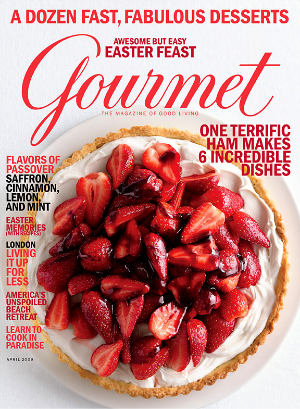Hard times aren’t always the worst times for magazines. In 1941, with the economy still depressed and the nation on the verge of war, a magazine called Gourmet hatched.
In the years since, Gourmet sprouted into the nation’s most celebrated and influential glossy food magazine. But this week–in the wake of another Great Crash and years into two grinding wars–hard times spelled doom for the “magazine of good living.”
What does its demise mean? One early reading is that Gourmet had badly lost touch with the times. In a witty Wednesday editorial, the Boston Globe declared Gourmet a “symbol of [a] bygone vision of gourmet life in America,” and a “sign that even upmarket niches can be too confining.”
Judith Jones, the legendary editor who ushered Julia Child’s Mastering the Art of French Cooking (among many other classic cookbooks) into being, echoed that sentiment. “Gourmet got away from the things that are going on in people’s homes, and seemed to be for an elite that got smaller and smaller,” Jones told the New York Times.
In this view, glossy celebrations of gracious living just don’t mix with 10 percent unemployment and stagnant wages. Move over, Gourmet, and make way for Every Day with Rachel Ray, a practical-minded magazine that has continued to thrive even as Gourmet‘s ad pages plunged.
But I think the out-of-touch explanation is too facile by half. True enough, Gourmet burned through cash like an Italian chef uses olive oil. One well-placed source tells me that a typical Gourmet photo shoot, all gorgeously rustic locations and impossibly beautiful models, could cost as much as $100,000. (To be fair, I’m also told that up until the Great Recession settled in, the magazine consistently turned a profit).
And while the magazine always maintained a reverence for the kind of aspirational living that characterized its post-War heyday, it has also evolved in ways that its post-mortem critics aren’t acknowledging. For years now, alongside elaborate spreads featuring splashy feasts, Gourmet has run plenty of the kind of 30-minute, weeknight-ready, simple-ingredient that have made Rachel Ray an icon. As a home cook on a limited time budget, I’ve successfully used these precisely written recipes dozens of times in the past several years.
More importantly, Gourmet has been a pioneer among its glossy peers in making space for a new and fast-growing appetite among American readers: the desire for critical perspectives on the food system. Since editor Ruth Reichl took the helm a decade ago, the magazine has run excellent articles on the quiet rise to ubiquity of genetically modified foods; the ecological damage wrought by industrial farming; the public health damage wrought by trans fats and the FDA’s limp response to it; and the abominable working conditions in Florida’s tomato fields.
While Reichl trail blazed food politics as a topic for glossies, few of her rival editors had the stomach to make more than baby steps in that direction. Yet given the popularity of books like Michael Pollan’s Omnivore’s Dilemma and Barbara Kingsolver’s Animal, Vegetable, Miracle, the foodie public clearly craves more information about where their food comes from.
In a sense, then, far from being out of touch with the times, late-model Gourmet was ahead of its time. No doubt, it was bleeding money, and no doubt, its parent company Condé Nast, could no longer afford to maintain its spendy ways. But rather than kill a vital and iconic asset like Gourmet, you could always simply cut its budget.
And this brings us to the real trend behind the Gourmet story: the power of axe-first, ask-later consultants in molding the media landscape in a time of crisis. For weeks now, according to various reports, grim-faced outsiders in suits have swarmed the Condé Nast offices. Employed by the consultancy McKinsey, their evident task is to scrutinize the books and hack away at anything not turning a profit.
Yet in their search for maximum short-term profit and return on invested capital, they tend to be myopic, unable to see beyond the next quarter’s bottom-line prospects. They are like the cynic in the Oscar Wilde play–they know the price of everything and the value of nothing. More than the dismal economy and ongoing changes in readers’ habits, the biggest threat to good journalism going forward could well be the unaccountable power of consultants.
Indeed, if public interest in the politics and ecology of food continues growing, Condé Nast execs may live to regret their decision to heed McKinsey’s counsel on this one. In throwing Gourmet to the dogs, they’ve sacrificed their one publication with a long track record in telling people where their food comes from–which it did in such a stylish and palatable way.
Note: The essay was first published on Huffington Post Green.



